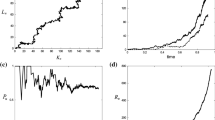Abstract
Standard neutral population genetics theory with a strictly fixed population size has important limitations. An alternative model that allows independently fluctuating population sizes and reproduces the standard neutral evolution is reviewed. We then study a situation such that the competing species are neutral at the equilibrium population size but population size fluctuations nevertheless favor fixation of one species over the other. In this case, a separation of timescales emerges naturally and allows adiabatic elimination of a fast population size variable to deduce the fluctuation-induced selection dynamics near the equilibrium population size. The results highlight the incompleteness of the standard population genetics with a strictly fixed population size.




Similar content being viewed by others
References
Gillespie, J.H.: Population Genetics: A Concise Guide. JHU Press, Baltimore (2010)
Ewens, W.J.: Mathematical Population Genetics: I. Theoretical Introduction. Springer, New York (2004)
Elena, S.F., Lenski, R.E.: Evolution experiments with microorganisms: the dynamics and genetic bases of adaptation. Nat. Rev. Genet. 4(6), 457 (2003)
Desai, M.M.: Statistical questions in experimental evolution. J. Stat. Mech. Theory Exp. 2013(01), P01003 (2013)
Barrick, J.E., Lenski, R.E.: Genome dynamics during experimental evolution. Nat. Rev. Genet. 14(12), 827 (2013)
Dai, L., Vorselen, D., Korolev, K.S., Gore, J.: Generic indicators for loss of resilience before a tipping point leading to population collapse. Science 336(6085), 1175 (2012)
Sanchez, A., Gore, J.: Feedback between population and evolutionary dynamics determines the fate of social microbial populations. PLoS Biol. 11(4), e1001547 (2013)
Griffin, A.S., West, S.A., Buckling, A.: Cooperation and competition in pathogenic bacteria. Nature 430(7003), 1024 (2004)
Nowak, M.A.: Evolutionary Dynamics: Exploring the Equations of Life. Harvard University Press, Cambridge (2006)
Hartl, D.L., Clark, A.G., et al.: Principles of Population Genetics, vol. 116. Sinauer Associates, Sunderland (1997)
Otto, S.P., Whitlock, M.C.: The probability of fixation in populations of changing size. Genetics 146(2), 723 (1997)
Wahl, L.M., Gerrish, P.J., Saika-Voivod, I.: Evaluating the impact of population bottlenecks in experimental evolution. Genetics 162(2), 961 (2002)
Wahl, L.M., Gerrish, P.J.: The probability that beneficial mutations are lost in populations with periodic bottlenecks. Evolution 55(12), 2606 (2001)
Patwa, Z., Wahl, L.: The fixation probability of beneficial mutations. J. R. Soc. Interface 5(28), 1279 (2008)
Parsons, T.L., Quince, C., Plotkin, J.B.: Absorption and fixation times for neutral and quasi-neutral populations with density dependence. Theor. Popul. Biol. 74(4), 302 (2008)
Parsons, T.L., Quince, C.: Fixation in haploid populations exhibiting density dependence II: The quasi-neutral case. Theor. Popul. Biol. 72(4), 468 (2007)
Lin, Y.T., Kim, H., Doering, C.R.: Features of fast living: on the weak selection for longevity in degenerate birth-death processes. J. Stat. Phys. 148(4), 647 (2012)
Kogan, O., Khasin, M., Meerson, B., Schneider, D., Myers, C.R.: Two-strain competition in quasineutral stochastic disease dynamics. Phys. Rev. E 90(4), 042149 (2014)
Parsons, T.L., Quince, C., Plotkin, J.B.: Some consequences of demographic stochasticity in population genetics. Genetics 185(4), 1345 (2010)
Fisher, R.A.: The Genetical Theory of Natural Selection: A Complete, Variorum edn. Oxford University Press, Oxford (1930)
Wright, S.: Evolution in mendelian populations. Genetics 16(2), 97 (1931)
Redner, S.: A Guide to First-Passage Processes. Cambridge University Press, Cambridge (2001)
Moran, P.A.P.: Random processes in genetics. In: Mathematical Proceedings of the Cambridge Philosophical Society, vol. 54, pp. 60–71. Cambridge University Press, Cambridge (1958)
Moran, P.A.P., et al.: The Statistical Processes of Evolutionary Theory. Oxford University Press, Oxford (1962)
Van Kampen, N.G.: Stochastic Processes in Physics and Chemistry, vol. 1. Elsevier, Amsterdam (1992)
Risken, H.: Fokker-Planck Equation. Springer, Berlin (1984)
Korolev, K., Avlund, M., Hallatschek, O., Nelson, D.R.: Genetic demixing and evolution in linear stepping stone models. Rev. Mod. Phys. 82(2), 1691 (2010)
Gardiner, C.: Handbook of Stochastic Processes. Springer, Berlin (1985)
Chotibut, T., Nelson, D.R.: Evolutionary dynamics with fluctuating population sizes and strong mutualism. Phys. Rev. E 92(2), 022718 (2015)
Pigolotti, S., Benzi, R., Perlekar, P., Jensen, M.H., Toschi, F., Nelson, D.R.: Growth, competition and cooperation in spatial population genetics. Theor. Popul. Biol. 84, 72 (2013)
Constable, G.W.A., McKane, A.J.: Models of genetic drift as limiting forms of the Lotka-Volterra competition model. Phys. Rev. Lett. 114, 3 (2015)
Constable, G.W.A., Rogers, T., McKane, A.J., Tarnita, C.E.: Demographic noise can reverse the direction of deterministic selection. Proc. Natl. Acad. Sci. 2016, 03693 (2016)
Parsons, T.L., Rogers, T.: Dimension reduction via timescale separation in stochastic dynamical systems. arXiv:1510.07031 (2015)
Hallatschek, O.: Noise driven evolutionary waves. PLoS Comput. Biol. 7(3), e1002005 (2011)
Houchmandzadeh, B., Vallade, M.: Selection for altruism through random drift in variable size populations. BMC Evol. Biol. 12, 61 (2012)
Houchmandzadeh, B.: Fluctuation driven fixation of cooperative behavior. Biosystems 127, 60–66 (2015)
Acknowledgements
This work was supported in part by the National Science Foundation (NSF) through Grants Nos. DMR-1608501 and DMR-1306367 and by the Harvard Materials Research Science and Engineering Laboratory, through MRSEC Grant No. DMR-1420570. Portions of this research were conducted during a stay at the Center for Models of Life at the Niels Bohr Institute, the University of Copenhagen. Computations were performed on the Odyssey cluster supported by the FAS Division of Science Research Computing Group at Harvard University.
Author information
Authors and Affiliations
Corresponding author
Rights and permissions
About this article
Cite this article
Chotibut, T., Nelson, D.R. Population Genetics with Fluctuating Population Sizes. J Stat Phys 167, 777–791 (2017). https://doi.org/10.1007/s10955-017-1741-y
Received:
Accepted:
Published:
Issue Date:
DOI: https://doi.org/10.1007/s10955-017-1741-y




